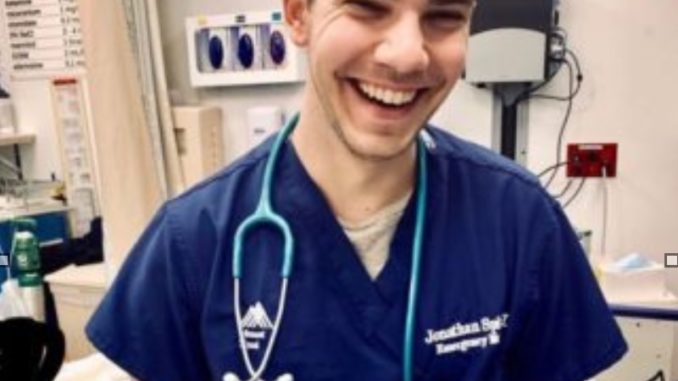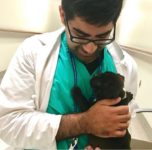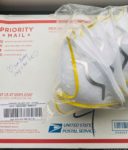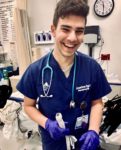
By SARAH RASLIN
QUEENS – Six days a week, Dr. Rohan Jotwani, 29, puts on his surgical gown, gloves, respiratory protection, eye protection or face shield, and N95 respirator – a mask for the nose and mouth that filters out at least 95% of airborne particles, in order to fight the COVID-19 national pandemic on the frontlines.

Dr. Jotwani has been moved from his usual hospital in upper Manhattan, to New York Presbyterian Queens Hospital, in Flushing, Queens, one of the epicenters of the virus. Outside stand the love ones of admitted patients, crying, begging, praying, and pleading, as they are not allowed to visit. Upon entry, hospital beds are seen put wherever they can fit, including the lobby, as the hospital is doing the best it can to keep up with the volume of admitted infected patients, although ill prepared.
“This disease is the real deal, there’s no sugar coating it. I have spent most of my 20s learning the medicine needed to keep our sickest Covid-19 patients alive and almost every day of the last three years tinkering with ventilators to know that the kind of support they need is truly extreme. Yet, I have faith that everyone on the frontlines are part of the smartest and most capable generation of healthcare providers the world has ever seen. There are no egos, no cost calculation and no politics anymore when taking care of these patients, just all of us coming together to do the right thing. We know enough to fix this. We just can’t fix it fast enough,” Dr. Jotwani said in an interview.
POSITIVES OUTCOMES OF PANDEMIC
Although the headlines have seemed to remain negative, the pandemic has had some lasting impacts that deem positive to society. For example, according to BBC, compared with this time last year, levels of pollution in New York have reduced by nearly 50% because of measures to contain the virus.
When Dr. Jotwani was asked how he is able to positive during Covid-19 he said;
“Each week since this pandemic has started has been a lifetime. Having been deployed to ICUs throughout my city, there’s this feeling of vastness in every single one. It’s one continuous sea of ventilators alarming, jumbled IV tubing and medically induced comas. Yet for all the morality and despair that lingers, there’s also been an incredible amount of resilience and spirit too. I never thought I’d live to see neurosurgeons, obstetricians and our orthopedic colleagues speaking fluent ventilator and anesthesia.”

“Yesterday, I received a package from a friend from college I haven’t spoken to in years. He sent me the masks he and his friends had been saving in case of forest fires in California. This, along with dozens of other examples of extraordinary human spirit and compassion, is what’s keeping many of us going.”
DECREASE IN COVID-19 CASES
According to The New York Times, Gov. Andrew M. Cuomo arrived to his daily coronavirus briefing in Albany, N.Y., on Saturday, April 18 with cautionary good news: The state has continued to make progress in its battle with a virus that has killed more than 13,000 residents, enough people to populate an upstate small city.
“If you look at the past three days, you could argue we are past the plateau and starting to descend,” Mr. Cuomo said. “So, we’re not at the plateau anymore, but we’re still not in a good position.”
Mr. Cuomo announced the state’s daily death toll from the virus had fallen to 540, down from 630 a day earlier, making it the lowest daily number in more than two weeks.
Still, he warned that the health crisis was far from over. On April 17 alone, about 2,000 people were admitted to city hospitals with Covid-19 symptoms, a number similar to what hospitals were seeing as the pandemic began to peak in late March.
As the number of statewide cases decrease and the weather gets warmer, citizens are becoming more confident and more restless when it comes to social distancing restrictions. When Dr. Jotwani was asked his thoughts on the plateau and eventual decrease of cases in an interview he said,
“Winning this will be our century’s moon landing, our ending smallpox, our storming the beaches of Normandy. We can’t mess it up now.”
New Video: Together we can stop the spread of #COVID19 by physical distancing, practicing good hygiene and avoiding non-essential travel. Watch to learn more about how you can help slow the spread. https://t.co/qKkt9oEm7M pic.twitter.com/bJnCgFuZLO
— CDC (@CDCgov) May 7, 2020
TWO DOCTORS: THEN AND NOW
INTERVIEW WITH DR. JON SPITZ

In an exclusive interview, Dr. Jon Spitz, 29, of Mt. Sinai West Hospital in Manhattan, described the differences of working in the emergency room one year ago versus working in the emergency room today.
“The biggest difference I can say is a year ago, there was really this diversity in pathology that you’d see; You’d see a little of everything, which is part of what drove me to emergency medicine. You kind of have to know a little about everything, like a jack of all trades of sorts. About a month or six weeks ago, when COVID-19 was at it’s height in New York City, it seemed like almost every patient was Corona Virus related. It was really intense. Every 20 minutes or so there would be another really intense resuscitation requiring either an intubation or maybe CPR or really all hands on deck. It was something out of a nightmare. It was really a big departure, I mean from what we’ve seen earlier in terms of diversity of patients. I’m not totally sure where a lot of those minor complaints went, but they stopped showing up about a month or six weeks ago.”
To what degree is the hospital or the department working with the caregivers, the doctors, and the nurses to deal with stress and responding to this moment?
“So, the hospitals have been great. They’ve provided; They’ve made coordination with different restaurants to give us food like all the time, so that’s just one less thing to worry about. They’ve provided barbers, they’ve just been kind of echoing the general public. The administrators for the most part have been really grateful for everything that we’re doing. They’ve provided buses for us so we can travel from home to the different Mt. Sinai Hospital locations in a responsible way, they’ve done a lot of little things to make this whole process easier on us.”
Dr. Spitz was then asked to paint a picture of the appreciation he is receiving as a doctor during the pandemic.
“The last few months have been..they’ve been really really hard and been really challenging for me most of the hours of the day, but the gratitude I’ve received outside of the hospital has been amazing. Every night at 7:00pm Manhattan at large claps, and cheers, and woos. I try to go outside for a second from the hospital if I can, but only a couple of times I’ve been able to. We’ve also gotten a lot of free food. Fortunately, a lot of restaurants been really generous with donating. Also, just people – I get texts and calls more so over the last few months than any other time I can recall. So It’s really really nice for me, and I think everybody in the medical world really appreciates the gratitude people have right now. It makes a difference.”
You didn’t sign up for COVID-19; To what degree has the pandemic impacted your view and experience on being an emergency room doctor?
“I mean, I didn’t sign up specifically for COVID-19, but I did sign up for exactly something like this. I signed up for treating people at their sickest, treating people when their most acute, dealing with really tough situations, both kind of emotionally, and also in terms of physiology, and so this has been really reaffirming in terms of wanting to do emergency medicine. I think there’s certainly days I come home from shift where I just want to be alone and sit on the couch, and it’s been really tough, but more broadly speaking, this has been a really reaffirming couple of months. I feel luck to have chosen the specialty I did.”

I really liked the interactive Adobe Spark video. It showed how the doctors chaanged from before the virus to now. It felt like I was there. I would like to know more about how the doctors are staying hopeful during these crazy times.